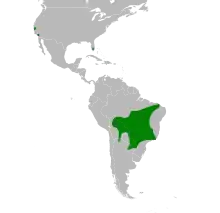Yellow-chevroned parakeet
The yellow-chevroned parakeet (Brotogeris chiriri) is native to tropical South America south of the Amazon River basin from central Brazil to southern Bolivia, Paraguay, and northern Argentina. Caged birds have been released in some areas, and the birds have established self-sustaining populations in the Miami, Florida, and Los Angeles and San Francisco, California. This bird seems to be doing better in its North American feral population than the closely related white-winged parakeet. The species is also established in the downtown area of Rio de Janeiro, Brazil; and in Buenos Aires, Argentina; where it was introduced. The native population in South America continues to do well.
| Yellow-chevroned parakeet | |
|---|---|
 | |
| In Belo Horizonte, Brazil. | |
| Scientific classification | |
| Domain: | Eukaryota |
| Kingdom: | Animalia |
| Phylum: | Chordata |
| Clade: | Dinosauria |
| Class: | Aves |
| Order: | Psittaciformes |
| Family: | Psittacidae |
| Genus: | Brotogeris |
| Species: | B. chiriri |
| Binomial name | |
| Brotogeris chiriri (Vieillot, 1818) | |
 | |
Description
The bird is 20–25 cm in length, and is mostly light green in color. It has a trailing yellow edge on its folded wings, which is also seen when the bird is in flight. It was considered conspecific with the white-winged parakeet until 1997. Wild birds primarily use disturbed forests and forest clearings around settlements. They rarely use deep tropical forests.
Diet
The bird feeds mostly on seeds and fruit in its native habitat, and feral populations have adapted to take in blossoms and nectar. During dry periods, which often leads to fruit scarcity, the bird adapts by eating more seeds, particularly from the plant Erythrina dominguezii.[2][3] These birds are also observed participating in Geophagia, being the deliberate ingestion of soil, commonly in location of clay licks.[4] Feral birds also come to bird feeders.
Breeding
Yellow-chevroned parakeets usually find holes in trees for nesting. They also form nesting tunnels in dead palm fronds. The female lays four to five eggs. After raising their young, all birds form rather large communal roosts until the next breeding season.
Gallery
References
- BirdLife International (2018). "Brotogeris chiriri". IUCN Red List of Threatened Species. 2018: e.T22685963A130103839. doi:10.2305/IUCN.UK.2018-2.RLTS.T22685963A130103839.en. Retrieved 13 November 2021.
- Ragusa-Netto, J. (2002). "Exploitation of Erythrina dominguezii Hassl. (Fabaceae)nectar by perching birds in a dry forest in western Brazil". Brazilian Journal of Biology. 62 (4b): 877–883. doi:10.1590/S1519-69842002000500018. ISSN 1519-6984.
- Ragusa-Netto, J. (2004). "Flowers, fruits, and the abundance of the yellow-chevroned parakeet (Brotogeris chiriri) at a gallery forest in the South Pantanal (Brazil)". Brazilian Journal of Biology. 64 (4): 867–877. doi:10.1590/S1519-69842004000500017. ISSN 1519-6984.
- Costa-Pereira, Raul; Severo-Neto, Francisco; Inforzato, Igor; Laps, Rudi Ricardo; Pizo, Marco Aurélio (2015). "Nutrients Drive Termite Nest Geophagy in Yellow-chevroned Parakeets ( Brotogeris chiriri )". The Wilson Journal of Ornithology. 127 (3): 506–510. doi:10.1676/14-142.1. ISSN 1559-4491.
Further reading
External links
- Yellow-chevroned Parakeet videos on the Internet Bird Collection
- Yellow-chevroned Parakeet photo gallery VIREO Photo-High Res--(Close-up)
- Photo-High Res; Article chandra.as.utexas.edu

.jpg.webp)

.jpg.webp)
.jpg.webp)
.jpg.webp)
.jpg.webp)